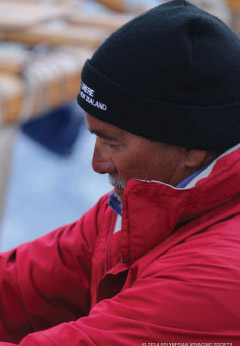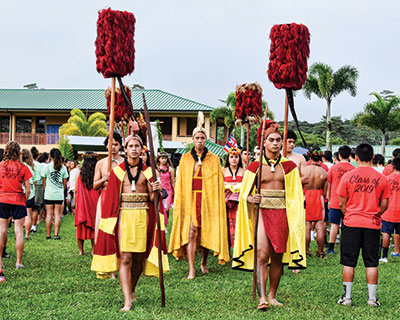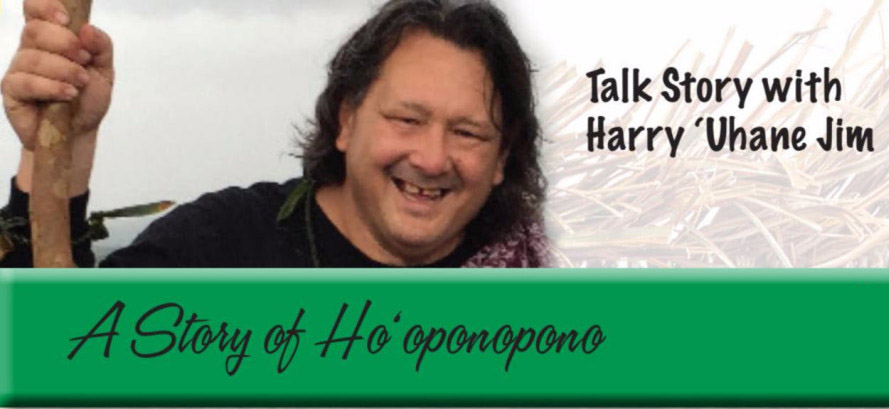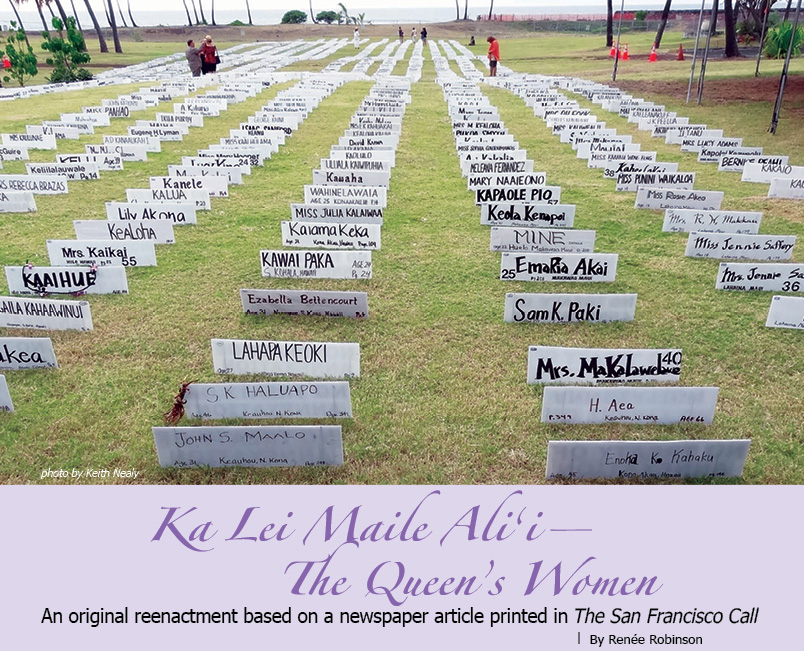
Ka Lei Maile Ali‘i—The Queen’s Women
An original reenactment based on a newspaper article printed in The San Francisco Call
 This story begins with a listing on KonaWeb.com.
This story begins with a listing on KonaWeb.com.
January 13, 2013 “KA LEI MAILE ALI‘I; THE QUEEN’S WOMEN,” A PLAY—KEAUHOU
A short play remembering a meeting in Hilo in 1897 when Hawaiians were urged to sign a petition protesting annexation. Features local actors in a staged reading.
The list of signers and signs showing their names will be on display.
Audience is invited to wear attire from 1800s and bring lei for the kūpuna signs.
The event will be held at the old Kona Lagoon Hotel site,
just south of Keauhou Beach Hotel on Ali‘i Drive in Keauhou.
Time: 1pm–3pm, Free to the public. Sponsored by Kona Hawaiian Civic Clubs.
I was inspired to attend and invited a friend to the event in Keauhou, not knowing what we would see. We arrived early and sat in the second row.
The moderator shared the play is based on an article Miriam Michelson wrote on Sept. 22, 1897 on the deck of the passenger ship Australia on her way home to San Francisco, and that we, the audience, were also actors in the play. We were at a meeting of the women’s branch of Hui Aloha ‘Āina in the Salvation Army Hall in Hilo on Hawai‘i Island in the Hawaiian Kingdom, Sept. 1897.
As the play began, I recognized cast members Sherry Bracken, a journalist on-island, and Ka‘ea Lyons of KAPA Radio. I took a few pictures and wrote some notes. Most of the actors were dressed in black. A couple of ladies walked up the center aisle stopping to greet people they knew along the way. Everyone read their parts with passion and conviction. I knew this event was important, although I didn’t know why.
Then the lady actor talking asked, “Shall we be deprived of our nationality?”
The audience responded, “ ‘Ae, pololei, aloha ‘āina.” (Yes, correct, we love our country.)
“Shall we be annexed to America?”
“A‘ole loa!” (Of course not! Never!)
I turned in my chair to take pictures of the audience participation. Once I felt the emotion behind the shouted words, the camera was put away.
As the play continued, with the audience participating, tears ran down my cheeks. Tears of sadness for the Hawaiian people. Tears of disgust of the people who created this tragedy. Tears of shame for not knowing the history of this land.
After the play was pau (done), the audience was able to see the signs on the lawn close up. It was a time for somber contemplation. The 2,000+ white signs looked like tombstones in a cemetery. Each sign included the name of an original signer, their age, where they lived, and the page number on the Kū‘ē Petition. The ages ranged from 12 to 92 from all islands.
A few last names I recognized. Were the Lindseys from Kohala ancestors of my friend Kari Ann’s husband Lindsay “Kaleo”? I wondered. (Later I found out he is related to them.)
At the end of the signs, I turned to head back to my car and saw row after row of “NO TREATY OF ANNEXATION.” The tears began again and my heart was heavy as it felt the horror of a country that had been killed. It took a few days to process the emotions for the people of this land.
Fast-forward to Jan. 8, 2014
Pua Case sent me a message asking if I would consider being one of the cast members and play the role of the reporter.
I flashed back to the year before when Sherry Bracken played the reporter and read her part from her script in hand. Ummm, reading I could do; memorizing, probably not.
The next morning I awoke with the thought, When a Hawaiian asks you to do something, your answer is Yes. My response to Pua read, “I’m willing to be a part of this. Just know that I may cry.”
Now that I agreed to play her part, I needed to research who was this Miriam Michelson?
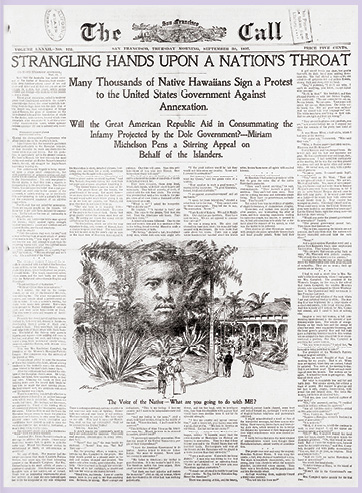 Miriam was born the seventh of eight children in the mining town of Calaveras, California in 1870.
Miriam was born the seventh of eight children in the mining town of Calaveras, California in 1870.
Her article, “Strangling Hands Upon a Nation’s Throat” was published in the The San Francisco Call, September 30, 1897 and is the basis for the play.
She began her writing career as a journalist, “interviewing a murderer one week and Paderewski the next” and “writing dramatic criticism of a very fearless and truth-telling sort,” according to a 1904 biographical note in Current Literature. Her first book, In the Bishop’s Carriage, was the fourth best-selling novel in 1904.
Lights, Camera, Action!
I was up earlier than normal on Jan. 16 for the drive to Waimea. Fortunately, there was time to have a quick run through of the play before the first of four seventh grade classes from Waimea Middle School arrived. Dot Ushima was my translator and a wonderful coach who said, “It’s ok to slow down when speaking.” Mahalo, Dot!
Dot has been with the play since it began. She knew the late Helen Edyth “Didi” M. Lincoln Lee Kwai who wrote, produced, and first directed the play. Its inception and fine-tuning was on the Mauna Makahilo on the island of O‘ahu. The play went all over America and to the major islands of Hawai‘i Nei. Each time, the people were asked to take the script and run with it in
each community.
Pua Case has worked with a group of educators and community members to coordinate this event in Waimea largely because her great grandmother Emma Pa‘a and other members of her own family, the Husseys from Kohala signed the petition.
Pua opened up each of the four reenactments with these comments to the audience: “Our gratitude is for every native and non-native who sat in that meeting that evening. You are those people who sat there: someone who was concerned about the future of Hawai‘i; someone who was afraid of what would happen if we were annexed, or taken over, by another country; someone who knew what they would lose—land, possessions, their spirit and soul.”
To listen to the keiki (children) speaking their parts during each play was awe-inspiring. Watching the kids’ eyes go wide when Pua shared about being put in jail was priceless. As they looked at the Kū‘ē Petition pages afterward, I wondered if they recognized any of the names, and if so, how were they related?
As we were finishing lunch and getting ready to do the fourth play, there was chanting from across the street. As if on cue, the Kanaka maoli actors from Kamuela gathered outside and chanted back, welcoming the Māori students and teachers from Aotearoa. Both Dot and I had tears in our eyes as we listened and watched.
Shortly after the play began, the Māori students and teachers entered the hall. The chairs were full so they sat on the floor to listen.
Before leaving, I asked Pua if the chanting between the two groups had been planned. Her reply, “It is simply protocol.”
Doing the play four times in one day is intense, at least for me. It was all I could do to drive back to Kailua-Kona and fall into bed.
After processing for a few days, I shared my learnings with Pua in an email:
Aloha Pua,
I meant what I said as I was leaving—that I got more out of the day than I gave.
When I realized the date that Miriam wrote the article, “Strangling Hands Upon a Nation’s Throat,” was Sept. 22, 1897 and I moved here Sept. 22, 2007—I knew it wasn’t a coincidence that I was playing her part in the reenactment.
As I asked “Uncle” Google about her, I learned her oldest brother, Albert, was the first American citizen to win a Nobel Prize for science. Her youngest brother, Charles, became a close assistant to Franklin D Roosevelt. She authored seven novels, the most famous was In the Bishop’s Carriage, which caused a sensation.
OK… I’m not seeing the connection.
Then on Thursday, Jan. 16, I listened to you, Pua, share four times about the courage of the people attending the meeting in 1897. How each of them could have been put in jail. You also talked about the courage of Miriam—being in a land with a lot of unrest and distrust and being in a building where non-Hawaiian’s weren’t really welcome. (Much less one who was taking notes.)
I felt the respect for Miriam. I felt the gratitude for her writing and documenting the truth. I felt the acknowledgement that because she wrote the article, people 100+ years later are learning the truth.
I felt confirmation.
I’ve been asking why I was called to this island. Recently I’ve been sensing that it is to document the stories. Thursday felt like an exclamation point—Yes, you are here to share the stories, so 100 years from now future generations will have the information available to learn from.
Mahalo nui loa, Renée”
Experience the Original Reenactment for Yourself (updated for 2016)
Ka Lei Maile Ali‘i—The Queen’s Women will be held Thursday, Jan. 14, 2016 at the Kahilu Town Hall. Each free presentation is scheduled for one hour and begin at 9am, 10:15am, 11:15am, and 12:30pm.
Daytime presentations are open to the community and all schools studying the events surrounding this time period in Hawaiian Monarchy.
The evening presentation begins at 6pm. Era attire encouraged.
Contact Pua Case for scheduling and information.
Contact writer Renée Robinson
The 2014 cast members
| Jennifer Bryan Renée Robinson Dot Uchima Keali‘i Bertelmann Ku‘ulei Keakealani Liliuokalani Ross Keala Kahuanui |
Moderator Narrator Miriam Mickelson Translator Minister Mrs. Kuaihelani Campbell Mrs. Emma Nāwahī Audience guide |
Comments from the cast
What being in the play meant to me
“I learned so much about my history, Hawai‘i’s history, and was able to experience literally first-hand an important part in the political history of Hawai‘i. One particular element of the play that was special for me was the usage of the Hawaiian language. I fully realized then the extent of literacy in our native language by the people of the land in those days; furthermore, that a translator was necessary for the one English speaking person in the room that day (the reporter) blew me away. Reenacting those events, speaking the words, and to my surprise, feeling the emotion of the day, moved me beyond what I imagined. I now believe in the words “you get into character” because within that experience I was truly able to live those words. Mahalo.”
Ku‘ulei Keakealani who played the role of Mrs. Emma Nāwahī
Why I said yes to being in the play
1) First, I wanted to feel the essence of the people’s plight during that era.
2) My maternal great grandfather, Hawaiian patriot John E. Bush, was a renegade and rubbed shoulders with Hawaiian patriot Joseph Kaho‘oluhi Nāwahīokalani‘ōpu‘u in the anti-annexation effort. They led the Ahahui Aloha Aina Hawai‘i. Joseph’s wife, Emma ‘A‘ima Nāwahī was secretary of the women’s auxiliary of that hui—Ahahui Aloha Aina Hawai‘i o Na Wahine o Ko Hawai‘i Pae‘aina (Women’s Hawaiian Patriotic League of the Hawaiian Islands)—under the leadership of Abigail Kuaihelani Campbell. They all had influence in the petition signing around the islands.
3) Hundreds of my kūpuna signed the Kū‘ē. More particularly my maternal grandmother then age 16 and maternal great grandmother [pg 9] who was also a member of the women’s hui, Kona district; my maternal grandfather then age 19 signed the Kū‘ē [pg 93]; my maternal great grandfather signed the Kū‘ē [pg 98].
4) Lastly, I’m a genealogist, and the Kū‘ē book is a gold mine to my work. Since being in the play, I feel connected to my kūpuna.
Dot Uchima who played the role of the translator
